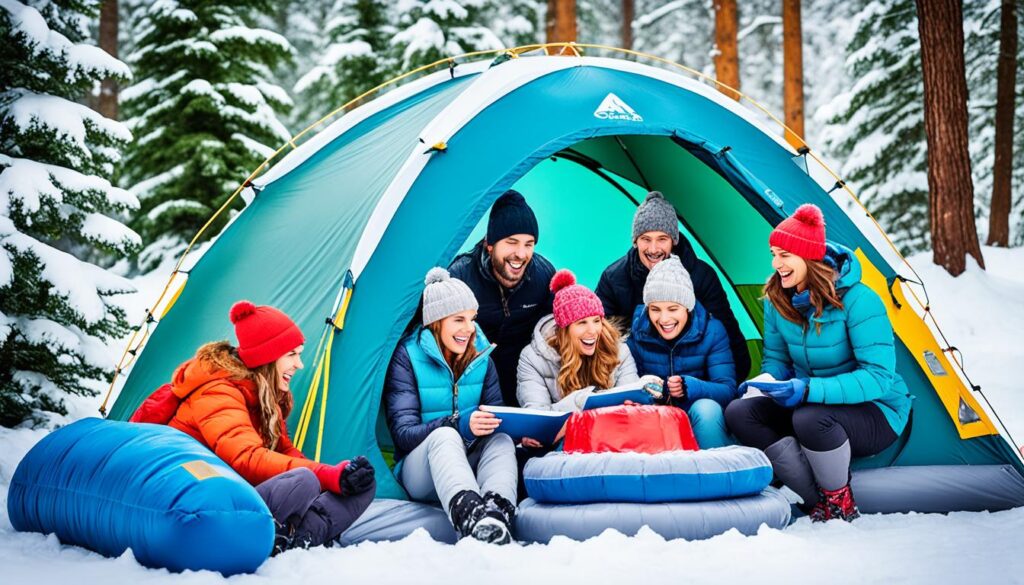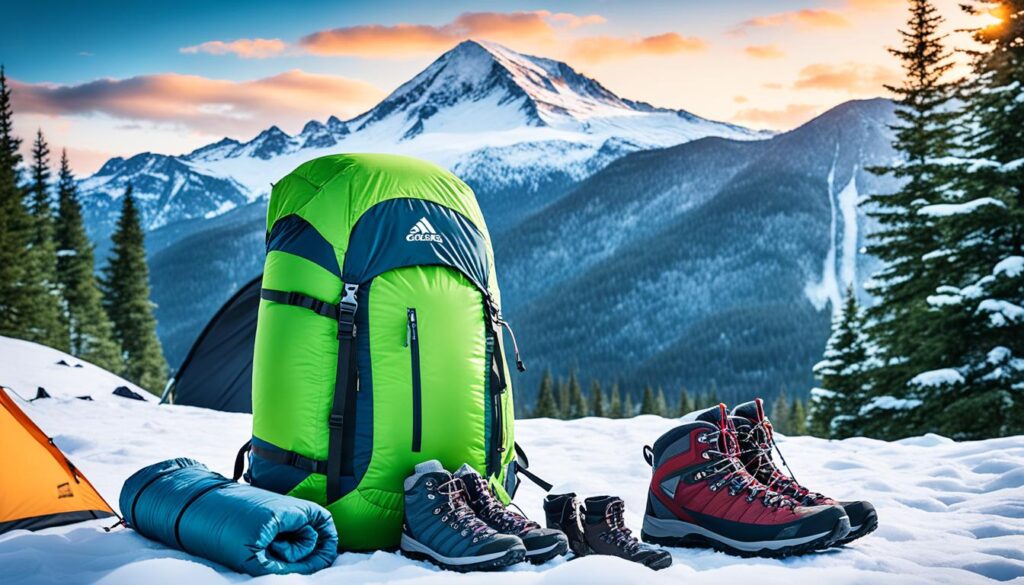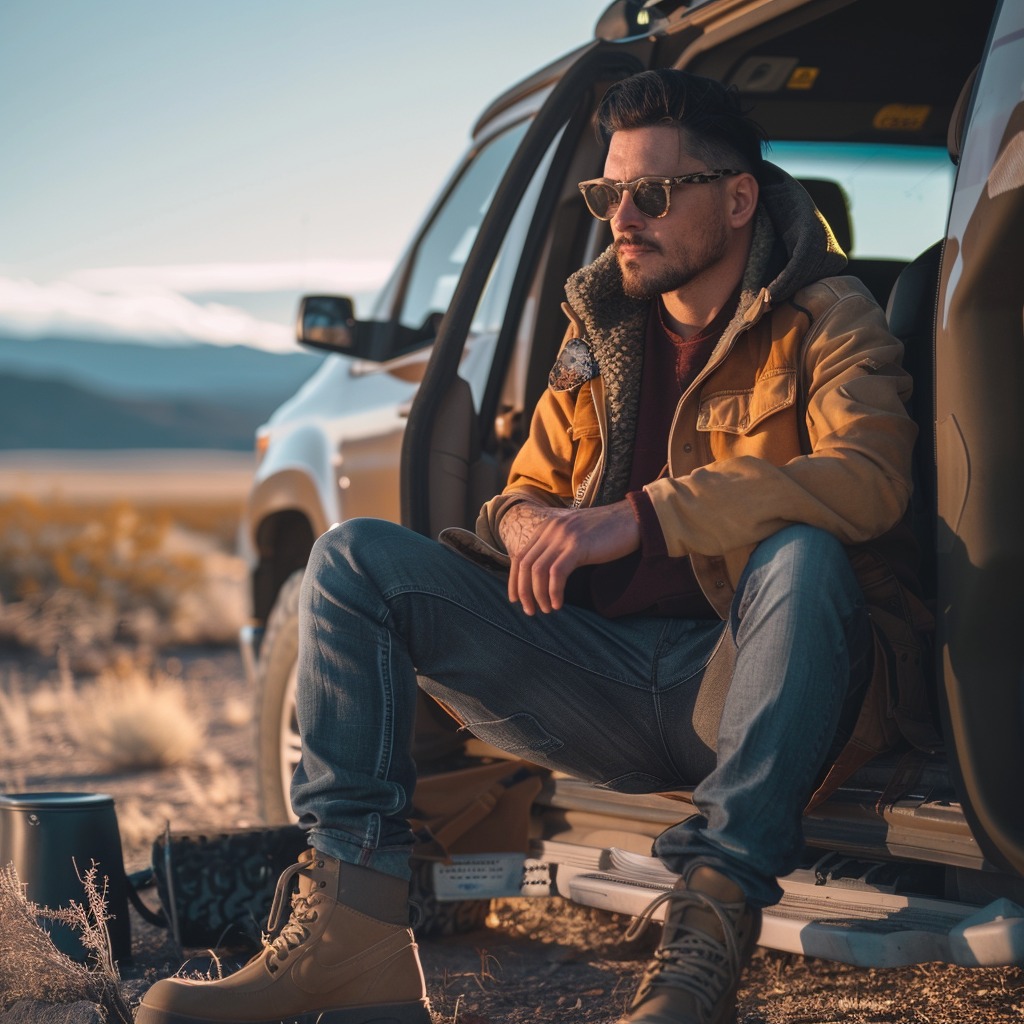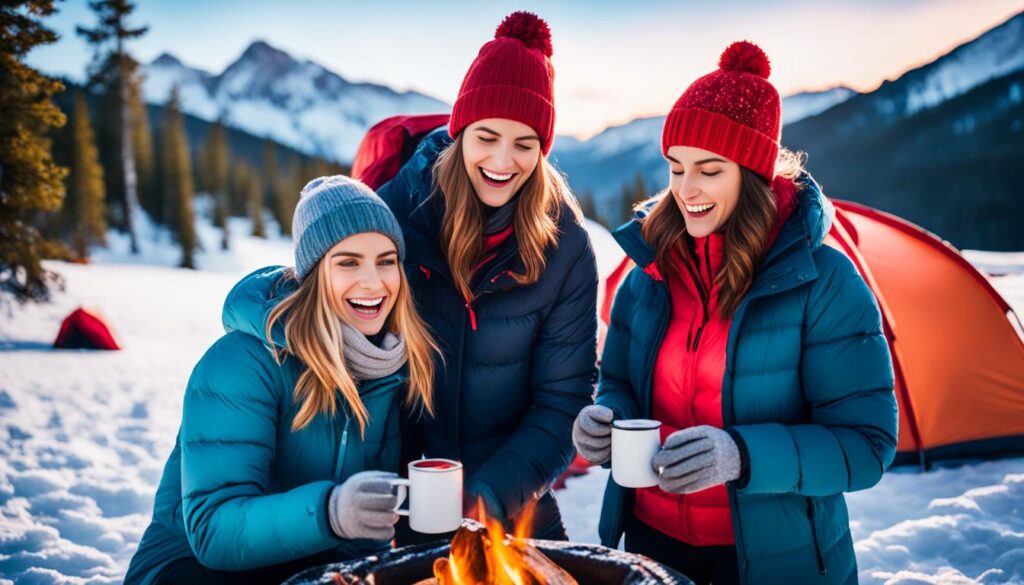Imagine waking up in the serene stillness of a winter morning, the crisp air filling your lungs as you step out of your cozy sleeping bag. The world around you is transformed into a winter wonderland, with snow-covered trees and glistening icicles. Winter camping with an inflatable tent offers a unique and exhilarating experience, allowing you to immerse yourself in the beauty of nature while staying warm and comfortable.
But this adventure requires proper preparation and knowledge to ensure a safe and enjoyable journey. In this guide, we will take you through all the essential tips and recommendations for winter camping with an inflatable tent. From selecting the right gear to insulating your tent, we’ve got you covered.
Key Takeaways:
- Winter camping with an inflatable tent offers a unique and exhilarating experience.
- Proper preparation and knowledge are essential for a safe and enjoyable winter camping trip.
- Choosing the right gear, including an inflatable tent designed for winter conditions, is crucial.
- Insulating your tent and selecting appropriate clothing are key to staying warm in cold weather.
- Setting up your winter campsite properly and following safety tips ensure a cozy and safe outdoor adventure.
What You Need to Know Before Winter Camping
Before embarking on a memorable winter camping trip, it is crucial to be fully prepared and well-informed. Taking necessary precautions and following safety guidelines will ensure a safe and enjoyable experience. Here are some important things to consider before heading out:
Check the Weather Forecast
Prior to your winter camping adventure, always check the weather forecast for your destination. Pay close attention to temperature fluctuations, wind speeds, and any incoming storms. This will help you plan accordingly and make informed decisions about your trip.
Winter Camping Safety Tips
It is vital to familiarize yourself with essential winter camping safety tips to protect yourself from potential hazards. Some important safety tips include:
“Always let someone know your camping plans and expected return time.”
“Pack emergency supplies, such as a first-aid kit, extra food, and water.”
“Ensure you have a reliable communication device, such as a two-way radio or satellite phone.”
“Avoid camping near frozen bodies of water, as the ice may not be stable and can be dangerous.”
Winter Camping Checklist
Having a comprehensive winter camping checklist is essential to ensure you have all the necessary gear and essentials for a successful trip. Below is a basic checklist to get you started:
- Warm sleeping bag
- Insulated sleeping pad
- Inflatable tent suitable for winter camping
- Appropriate clothing layers (base layers, insulating layers, outer layers)
- Cold weather accessories (hats, gloves, wool socks)
- Winter hiking boots
- Cooking stove and fuel
- Food and water
- Lighting equipment (headlamp, flashlight)
- Navigation tools (compass, map)
- Fire-starting materials
Remember, this is just a starting point, and you should customize your checklist based on your individual needs and the specific requirements of your camping location.
Choosing the Right Winter Camping Gear
When it comes to winter camping gear, one of the most important considerations is choosing the right inflatable tent. A reliable and sturdy tent is crucial in ensuring a comfortable and safe camping experience in cold and snowy conditions. Look for a four-season tent specifically designed for winter camping, as they are equipped with features that can withstand heavy snowfall and strong winds. These tents generally have stronger frames, thicker walls, and durable materials that offer better insulation and protection.
Here are some key features to look for when selecting the best inflatable tent for winter camping:
- Strong Construction: Opt for a tent with robust construction, such as reinforced poles and double-stitched seams, to withstand the weight of snow and the force of strong winds.
- Thermal Insulation: Choose a tent with good thermal insulation properties to keep you warm during cold winter nights. Look for models with insulated walls and floors, as well as rainfly coverings that can provide an additional layer of insulation.
- Wind Resistance: Look for a tent with a sturdy design that can withstand strong winds. Features like a streamlined shape, guy lines, and wind-resistant materials can help improve stability and reduce wind noise.
- Condensation Management: Consider tents with proper ventilation systems to prevent condensation buildup inside the tent. This ensures a dry and comfortable environment throughout your camping trip.
While inflatable tents provide convenience and ease of setup, they may require additional insulation for winter camping. One way to insulate an inflatable tent is by lining the interior with unworn clothes or blankets. Placing a tarp or a heavier emergency blanket on the ground beneath the tent can also provide an extra layer of insulation from the cold ground. These simple measures can significantly improve the warmth and comfort of your inflatable tent in winter conditions.
Choosing the right winter camping gear, including the best inflatable tent, is essential for a successful and enjoyable winter camping experience. By investing in a tent specifically designed for winter conditions and taking steps to insulate it properly, you can stay warm, comfortable, and well-protected from the elements during your winter camping adventures.
Selecting a Warm Sleeping Bag
A warm sleeping bag is essential for staying comfortable during winter camping. When choosing a sleeping bag, it is important to consider the expected low temperatures and select one with an appropriate temperature rating. A 15-degree bag is generally recommended for cold weather camping, but personal preferences and tolerance to the cold may vary.
Consider the following options for a warm and cozy winter camping experience:
| Sleeping Bag | Temperature Rating |
|---|---|
| Big Agnes 15-degree Sleeping Bag | 15 degrees Fahrenheit |
| Sea to Summit Trek TkIII 10 Sleeping Bag | 10 degrees Fahrenheit |
Both the Big Agnes 15-degree Sleeping Bag and the Sea to Summit Trek TkIII 10 Sleeping Bag are reliable options for winter camping. They offer excellent insulation and are designed to keep you warm even in frigid temperatures.
If you tend to get cold easily or expect extremely low temperatures, you can opt for a sleeping bag with a lower temperature rating. It is important to find a balance between warmth and comfort, ensuring you have a good night’s sleep even in cold conditions.
Why Temperature Rating Matters
A sleeping bag’s temperature rating indicates the lowest temperature at which it can keep the average sleeper warm. It is crucial to choose a sleeping bag with a temperature rating that matches the expected conditions. Sleeping in a bag with an inappropriate rating can result in discomfort, cold nights, and even health risks.
When preparing for winter camping, be sure to add a warm sleeping bag to your cold weather camping essentials. By choosing a sleeping bag with a suitable temperature rating and quality insulation, you can stay snug and comfortable throughout your winter camping adventure.
Choosing an Insulated Sleeping Pad
An insulated sleeping pad is a crucial addition to your winter camping gear, as it provides insulation from the cold ground and helps you stay comfortable throughout the night. When selecting an insulated sleeping pad, it is important to consider its insulation capability, indicated by the R-value.
The R-value measures the ability of a material to resist heat flow, with higher values indicating better insulation. For cold weather camping, look for a sleeping pad with a high R-value to ensure maximum warmth and comfort. This will help prevent the cold ground from drawing heat away from your body, keeping you cozy throughout the night.
Two recommended options for insulated sleeping pads are the Big Agnes Divide Insulated Sleeping Pad and the Therm-a-Rest NeoAir XLite NXT Sleeping Pad. Both these sleeping pads offer excellent insulation properties and are designed to keep you warm even in the coldest temperatures.
Big Agnes Divide Insulated Sleeping Pad:
- Insulation: Designed with PrimaLoft® Silver insulation, which provides exceptional warmth, water resistance, and breathability.
- R-Value: Boasts an impressive R-value of 4.5, making it suitable for winter camping.
- Comfort: Features a quilted top for added comfort and a smooth sleeping surface.
- Portability: Lightweight and compact, making it easy to carry during your winter camping trips.
Therm-a-Rest NeoAir XLite NXT Sleeping Pad:
- Insulation: Utilizes ThermaCapture™ technology, which traps radiant heat and provides excellent insulation.
- R-Value: Offers an R-value of 4.2, ensuring reliable warmth in cold weather.
- Comfort: Boasts a Triangular Core Matrix™ construction that provides exceptional stability and support while sleeping.
- Portability: Packs down to a small size and is lightweight, making it ideal for backpacking and winter camping adventures.
Investing in a high-quality insulated sleeping pad is essential to enhance your overall camping experience and ensure a good night’s sleep in cold weather. Choose a sleeping pad that suits your needs and enjoy the warmth and comfort it provides during your winter camping escapades.

Clothing Essentials for Winter Camping
Proper clothing is essential for staying warm during winter camping. To ensure maximum comfort and protection, it’s important to layer your clothing effectively. Here are the essential clothing items you should include in your winter camping checklist:
Base Layers:
Choose base layers made of wool or polyester to effectively wick away sweat and keep your body dry. These materials are known for their moisture-wicking properties, which help regulate body temperature and minimize moisture buildup. Opt for long-sleeved tops and thermal leggings to provide maximum coverage.
Middle Layers:
Puffy jackets or fleece jackets are ideal for insulation during cold weather camping. These layers create a thermal barrier, trapping heat close to your body. Consider packing multiple middle layers to adjust to varying temperatures. These items are highly versatile and can be worn separately or as part of a layered system.
Outer Layers:
Invest in high-quality rain and wind jackets to protect yourself from the elements. Look for waterproof and windproof options that provide excellent ventilation to prevent overheating. These outer layers should have adjustable cuffs, hoods, and hemlines to provide a snug fit and maximum protection.
Cold Weather Accessories:
- Beanies/Hats: Keep your head and ears warm with a beanie or hat that covers your entire head.
- Gloves: Opt for insulated and waterproof gloves to keep your hands warm and dry.
- Wool Socks: Invest in wool socks to keep your feet warm and prevent moisture buildup.
Winter Hiking Boots:
Choosing the right footwear is crucial for winter camping. Look for winter hiking boots that provide excellent insulation, traction, and waterproofing. These boots should have a sturdy sole and ankle support to navigate snowy and uneven terrain easily.
Remember, layering your clothing is key to regulating your body temperature and staying comfortable in cold weather. Be prepared for changing conditions by including these clothing essentials in your winter camping checklist.
| Clothing Item | Recommended Brands |
|---|---|
| Base Layers | Icebreaker, Smartwool |
| Middle Layers | Patagonia, The North Face |
| Outer Layers | Arc’teryx, Columbia |
| Cold Weather Accessories | Outdoor Research, Black Diamond |
| Winter Hiking Boots | Salomon, Merrell |

Setting Up Your Winter Campsite
When it comes to winter camping, setting up your campsite correctly is essential for a safe and comfortable experience. Follow these tips to ensure you create a well-protected and insulated environment:
- Choose the right location: Look for a flat and sheltered spot with vegetation that can act as a natural windbreak. This will help shield your campsite from strong winds and provide additional insulation.
- Anchoring your inflatable tent: Properly anchoring your inflatable tent is crucial to prevent it from being blown away by strong gusts of wind. Secure your tent using sturdy stakes and make sure all guy lines are taut.
- Insulate your tent: Insulating your tent is essential for maintaining warmth during winter camping. Line the inside of your tent with unworn clothes, which will act as an additional layer of insulation.
- Add heavier emergency blankets: For extra insulation, attach heavier emergency blankets to the walls and ceiling of your inflatable tent. This will help trap heat inside and keep the cold air out.
- Create wind-breaking walls: Use snow or built-in walls with tarps to create windbreaks around your campsite. This will provide additional protection from cold winds and help retain heat.
- Build a vestibule: Digging out a vestibule in front of your tent can provide extra space and act as a barrier against the elements. It serves as the entrance area and minimizes the amount of cold air that enters your tent.
Following these winter camping safety tips and properly setting up your campsite will ensure you have a comfortable and secure experience in the snow-covered wilderness.
| Setting Up Your Winter Campsite Checklist |
|---|
| Choose a flat and sheltered location |
| Anchoring your inflatable tent |
| Insulate your tent with unworn clothes |
| Add heavier emergency blankets |
| Create wind-breaking walls |
| Build a vestibule |
Conclusion
Winter camping with an inflatable tent can be an incredible experience when you are well-prepared. By following these winter camping tips, you can ensure a cozy and safe outdoor adventure. One of the most crucial aspects is choosing the right gear. Invest in a four-season inflatable tent specifically designed for winter camping to withstand heavy snowfall and strong winds.
In addition to the right gear, insulating your tent is key to staying warm throughout the night. Consider lining your inflatable tent with unworn clothes and using a tarp or heavier emergency blanket for added insulation. This will help trap heat and keep out the cold air, ensuring a comfortable camping experience.
Don’t forget to dress appropriately for winter camping. Layer your clothing to regulate your body temperature and protect against the elements. Opt for wool or polyester base layers, puffy jackets or fleece jackets for insulation, and wind and rain jackets for outer protection. Winter hiking boots are essential to keep your feet warm and dry on snowy terrain.
Lastly, setting up your winter campsite correctly is crucial. Find a flat and sheltered spot with vegetation that can shield you from the wind. Properly anchor your inflatable tent and build wind-breaking walls for added protection. Follow winter camping safety tips and enjoy the beauty of winter camping with your inflatable tent. Stay warm, be safe, and have a memorable winter camping experience!
Recommended
- BEST BED TENT TO BLOCK OUT LIGHT FOR SLEEP
- BED TENT FOR TRAVEL: SLEEP COZY ON-THE-GO
- INDOOR BED TENT FOR CAMPING COMFORT & FUN

Meet Noah, the soul behind “Best Inflatable Tent” and a true wanderer at heart. Living the van life, Noah has turned his passion for exploring the great outdoors into a lifestyle, earning his living through organizing group travels that bring people closer to nature. With years of firsthand experience in the wild, Noah’s expertise in selecting and utilizing inflatable tents is unparalleled. Through this blog, he shares his profound knowledge and practical tips to help fellow adventurers find their perfect outdoor shelters. Noah’s commitment to delivering genuine, tested insights has made him a trusted authority in the camping community. Join him on this journey to discover the best inflatable tents that make the great outdoors feel like home.
